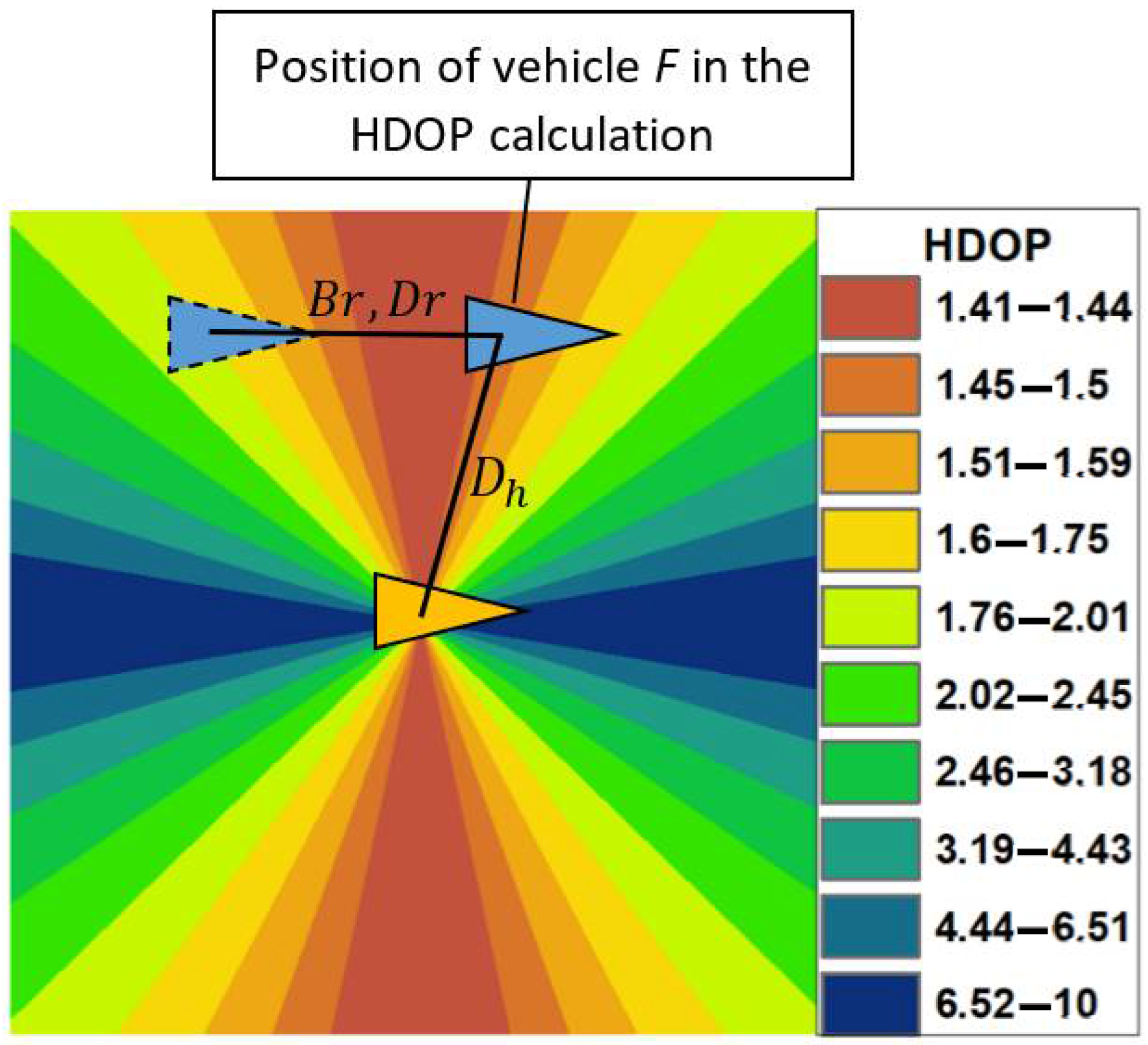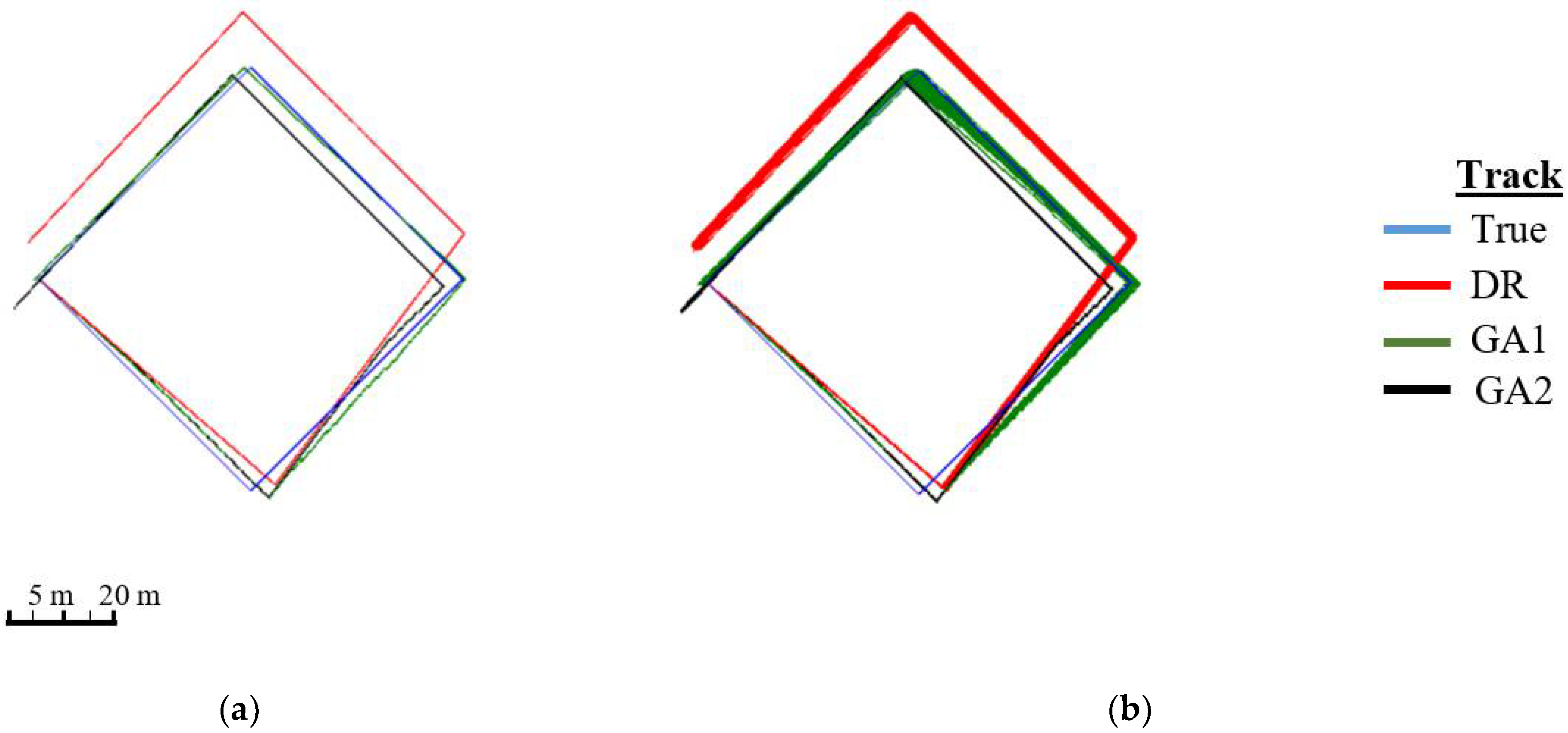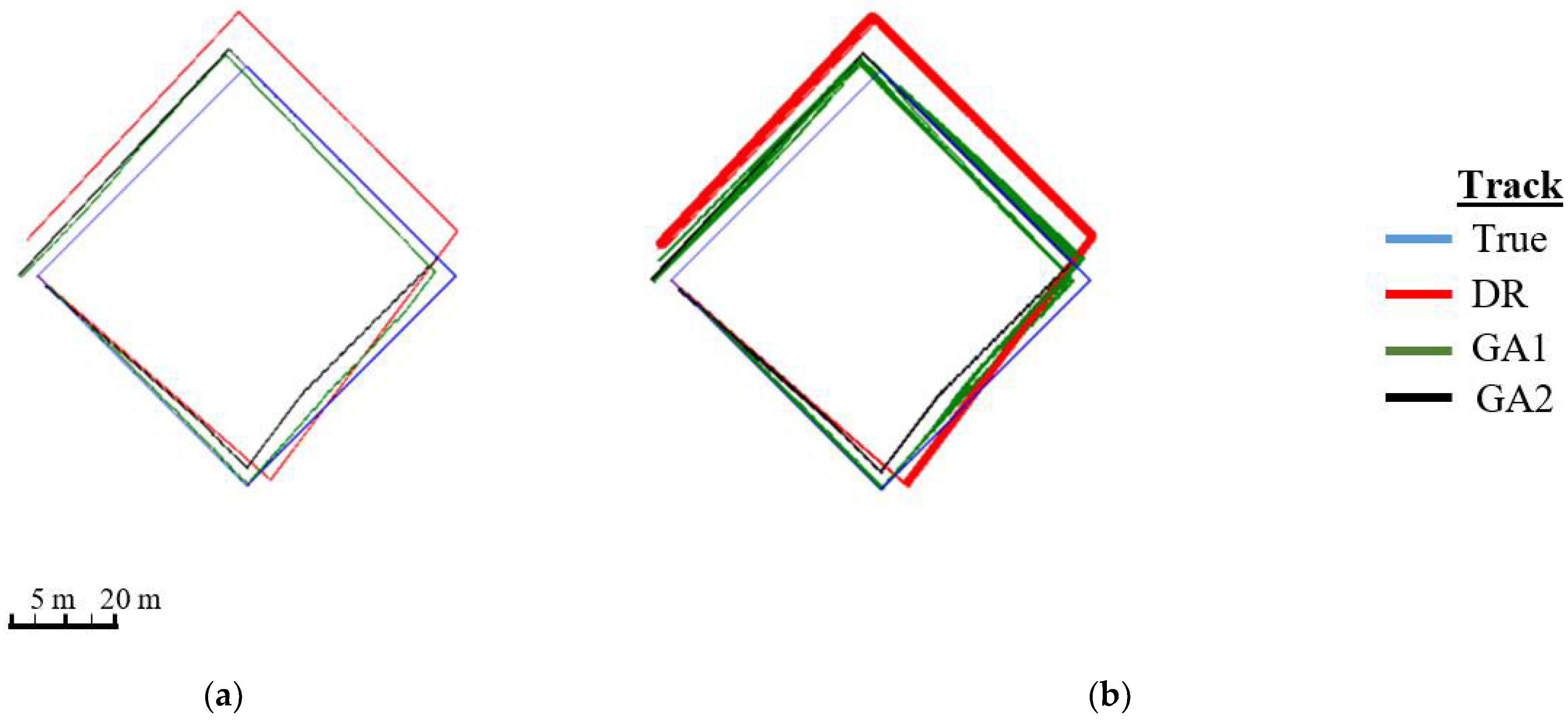Applying the Geodetic Adjustment Method for Positioning in Relation to the Swarm Leader of Underwater Vehicles Based on Course, Speed, and Distance Measurements
Abstract
:1. Introduction
2. Materials and Methods
3. Results
- course , measured with the INS "VN-100" with a frequency of Hz and (value provided by the manufacturer in the documentation) [16],
- speed , measured with the "Alize" logo with the frequency of Hz and (value provided by the manufacturer in the documentation) [17],
- distance , measured with the underwater acoustic modem "HS" with a frequency of Hz and 0.1 m (value adopted arbitrarily) [18].
- simulating successive reference positions of the trajectory of movements concerning vehicles L and F using the DR method with a constant time step on the basis of initial, constant (reference) values of the course and speed and calculating the reference distance ;
- simulating the values of the first corrections:
- ○
- , added to the reference course value ,
- ○
- , added to the reference speed value ,
- ○
- , added to the reference distance value
- estimating the coordinates of the position of vehicle F using the DR method on the basis of:
- ○
- ,
- ○
- ;
- estimating the coordinates of the position of vehicle F using the DR method in combination with GA1 and GA2 methods on the basis of:
- ○
- +,
- ○
- ,
- ○
- +;
- processing the resulting data into reference drawings with the reference and estimated trajectories of vehicle F, graphs of the distance to the reference position from the estimated position, as well as statistical parameters, i.e., maximum values, arithmetic means, standard deviations of the distance to the reference position from the estimated position.
3.1. Test No. 1
- (initial), Hz, ;
- , Hz, ;
- , Hz,
3.2. Test No. 2
3.3. Test No. 3
- ,
- ,
- ,
4. Discussion
- Test No. 1 (vehicles moving side by side, correct HDOP coefficient) showed that the maximum value, the arithmetic mean, and the standard deviation of the distance to the reference position in the case of positions estimated using the GA1 method are about two times smaller when compared to the distance from positions estimated using the GA2 method, and about three times smaller when compared to the distance from positions estimated using the DR method.
- Test No. 2 (vehicles moving one after the other, incorrect HDOP coefficient) showed that in the case of positions estimated using the GA1 and GA2 methods, the maximum value, the arithmetic mean, and the standard deviation of the distance to the reference position are approximately equal, even though still two times smaller when compared to the distance from the positions estimated with the DR method.
- 0.73 m and 0.5 m for GA1 as well as 0.77 m and 0.52 m for GA2—in the case of test No. 3,
- 3.48 m and 2.41 m for GA1 and 7.7 m and 3.63 m for GA2—in the case of test No. 1.
5. Conclusions
- the GA2 method is most impacted by systematic measurement errors, most often occurring in the case of poorly calibrating navigation devices for working in terms of the on-board navigation system,
- both methods provide a higher accuracy of estimating position coordinates on abeam angles of the swarm leader (relative bearing equal to approximately ±90°),
- in order to significantly increase the accuracy of estimating position coordinates using both methods, the values of systematic errors of measurements should be minimized (e.g., by calibrating navigation devices to work in terms of the on-board navigation system using a satellite compass and a GNSS RTK receiver),
- the accuracy of estimating coordinates using both methods can also be increased (although to a much lesser extent than in the case of systematic errors) by very accurately and frequently determining the mean error values of the course and speed measurements (e.g., before the start of each task performed by a swarm of vehicles).
- estimating position coordinates taking into account course, speed, and distance measurement errors (in the case of the GA 2 method),
- estimating position coordinates taking into account course, speed, and distance measurement errors as well as the geometric shape of the measurement system (in the case of the GA1 method),
- short calculation time and guaranteeing iterative convergence.
Author Contributions
Funding
Data Availability Statement
Conflicts of Interest
References
- Krzysztof, N.; Aleksander, N. The Positioning Accuracy of BAUV Using Fusion of Data from USBL System and Movement Parameters Measurements. Sensors 2016, 16, 1279. [Google Scholar] [CrossRef] [PubMed] [Green Version]
- Rigby, P.; Pizarro, O.; Williams, S. Towards Geo-Referenced AUV Navigation Through Fusion of USBL and DVL Measurements. In Proceedings of the OCEANS 2006, Boston, MA, USA, 18–21 September 2006; pp. 1–6. [Google Scholar]
- Lee, P.; Shim, H.; Baek, H.; Kim, B.; Park, J.; Jun, B.; Yoo, S. Navigation System for a Deep-sea ROV Fusing USBL, DVL, and Heading Measurements. J. Ocean Eng. Technol. 2017, 31, 315–323. [Google Scholar] [CrossRef] [Green Version]
- Barisic, M.; Vasilijevic, A.; Nad, D. Sigma-point Unscented Kalman Filter used for AUV navigation. In Proceedings of the 2012 20th Mediterranean Conference on Control & Automation (MED), Barcelona, Spain, 3–6 July 2012; pp. 1365–1372. [Google Scholar]
- José, M.; Aníbal, M. Survey on advances on terrain based navigation for autonomous underwater vehicles. Ocean Eng. 2017, 139, 250–264. [Google Scholar]
- Zhang, T.; Shi, H.; Chen, L.; Li, Y.; Tong, J. AUV Positioning Method Based on Tightly Coupled SINS/LBL for Underwater Acoustic Multipath Propagation. Sensors 2016, 16, 357. [Google Scholar] [CrossRef] [PubMed] [Green Version]
- Chen, Y.; Zheng, D.; Miller, P.A.; Farrell, J.A. Underwater Inertial Navigation With Long Baseline Transceivers: A Near-Real-Time Approach. IEEE Trans. Control Syst. Technol. 2016, 24, 240–251. [Google Scholar] [CrossRef]
- Lee, P.-M.; Jun, B.-H. Pseudo long base line navigation algorithm for underwater vehicles with inertial sensors and two acoustic range measurements. Ocean Eng. 2007, 34, 416–425. [Google Scholar] [CrossRef]
- Jianhua, B.; Daoliang, L.; Xi, Q.; Rauschenbach, T. Integrated navigation for autonomous underwater vehicles in aquaculture: A review. Inf. Process. Agric. 2020, 7, 139–151. [Google Scholar]
- Karimi, M.; Bozorg, M.; Khayatian, A.R. A comparison of DVL/INS fusion by UKF and EKF to localize an autonomous underwater vehicle. In Proceedings of the 2013 First RSI/ISM International Conference on Robotics and Mechatronics (ICRoM), Tehran, Iran, 13–15 February 2013; pp. 62–67. [Google Scholar]
- Dajun, S.; Cuie, Z.; Miao, Y.; Yixian, S. Research and Implementation on Multi-beacon Aided AUV Integrated Navigation Algorithm Based on UKF. In Proceedings of the 2nd International Conference on Vision, Image and Signal Processing (ICVISP 2018), Association for Computing Machinery, New York, NY, USA, 27 August 2018; pp. 1–5. [Google Scholar] [CrossRef]
- Almeida, J.; Matias, B.; Ferreira, A.; Almeida, C.; Martins, A.; Silva, E. Underwater Localization System Combining iUSBL with Dynamic SBL in ¡VAMOS! Trials. Sensors 2020, 20, 4710. [Google Scholar] [CrossRef] [PubMed]
- Miller, A.; Miller, B.; Miller, G. Navigation of Underwater Drones and Integration of Acoustic Sensing with Onboard Inertial Navigation System. Drones 2021, 5, 83. [Google Scholar] [CrossRef]
- González-García, J.; Gómez-Espinosa, A.; Cuan-Urquizo, E.; García-Valdovinos, L.G.; Salgado-Jiménez, T.; Cabello, J.A.E. Autonomous Underwater Vehicles: Localization, Navigation, and Communication for Collaborative Missions. Appl. Sci. 2020, 10, 1256. [Google Scholar] [CrossRef]
- Normal_Distribution Class Template. Available online: https://cplusplus.com/reference/random/normal_distribution/ (accessed on 29 September 2022).
- IMU VN-100 User Manual. Available online: https://www.vectornav.com/products/detail/vn-100 (accessed on 29 September 2022).
- Electromagnetic Speed Log Alize. Available online: https://cdn.echomastermarine.co.uk/assets/Uploads/Ben-Marine-ALIZE-EM-Log.pdf (accessed on 20 September 2022).
- HS Underwater Acoustic Modems. Available online: https://evologics.de/acoustic-modem/hs (accessed on 23 September 2022).
- C++Builder. Available online: https://www.embarcadero.com/products/cbuilder (accessed on 25 September 2022).
- Eigen is a C++ Template Library for Linear Algebra. Available online: https://eigen.tuxfamily.org/index.php?title=Main_Page (accessed on 20 September 2022).








| Positioning Method | Maximum Distance to the Reference Position (m) | Arithmetic Mean of the Distance to the Reference Position (m) | Standard Deviation Distance to Reference Position (m) | |||
|---|---|---|---|---|---|---|
| Single Test Sample | 100 Test Samples | Single Test Sample | 100 Test Samples | Single Test Sample | 100 Test Samples | |
| DR | 22.31 | 23.70 | 14.26 | 14.13 | 6.44 | 6.34 |
| GA1 | 8.39 | 8.57 | 3.42 | 3.48 | 2.39 | 2.41 |
| GA2 | 15.36 | 15.36 | 7.90 | 7.70 | 3.68 | 3.63 |
| Positioning Method | Maximum Distance to the Reference Position (m) | Arithmetic Mean of the Distance to the Reference Position (m) | Standard Deviation Distance to Reference Position (m) | |||
|---|---|---|---|---|---|---|
| Single Test Sample | 100 Test Samples | Single Test Sample | 100 Test Samples | Single Test Sample | 100 Test Samples | |
| DR | 22.31 | 23.71 | 14.25 | 14.13 | 6.43 | 6.34 |
| GA1 | 9.98 | 10.77 | 5.78 | 6.57 | 3.43 | 3.81 |
| GA2 | 10.81 | 10.89 | 8.12 | 8.20 | 2.99 | 2.89 |
| Positioning Method | Maximum Distance to the Reference Position (m) | Arithmetic Mean of the Distance to the Reference Position (m) | Standard Deviation Distance to Reference Position (m) | |||
|---|---|---|---|---|---|---|
| Single Test Sample | 100 Test Samples | Single Test Sample | 100 Test Samples | Single Test Sample | 100 Test Samples | |
| DR | 2.52 | 3.79 | 1.56 | 1.46 | 0.72 | 0.78 |
| GA1 | 0.91 | 2.55 | 0.39 | 0.73 | 0.21 | 0.50 |
| GA2 | 1.6 | 3.19 | 0.69 | 0.77 | 0.40 | 0.52 |
Publisher’s Note: MDPI stays neutral with regard to jurisdictional claims in published maps and institutional affiliations. |
© 2022 by the authors. Licensee MDPI, Basel, Switzerland. This article is an open access article distributed under the terms and conditions of the Creative Commons Attribution (CC BY) license (https://creativecommons.org/licenses/by/4.0/).
Share and Cite
Naus, K.; Piskur, P. Applying the Geodetic Adjustment Method for Positioning in Relation to the Swarm Leader of Underwater Vehicles Based on Course, Speed, and Distance Measurements. Energies 2022, 15, 8472. https://doi.org/10.3390/en15228472
Naus K, Piskur P. Applying the Geodetic Adjustment Method for Positioning in Relation to the Swarm Leader of Underwater Vehicles Based on Course, Speed, and Distance Measurements. Energies. 2022; 15(22):8472. https://doi.org/10.3390/en15228472
Chicago/Turabian StyleNaus, Krzysztof, and Paweł Piskur. 2022. "Applying the Geodetic Adjustment Method for Positioning in Relation to the Swarm Leader of Underwater Vehicles Based on Course, Speed, and Distance Measurements" Energies 15, no. 22: 8472. https://doi.org/10.3390/en15228472






